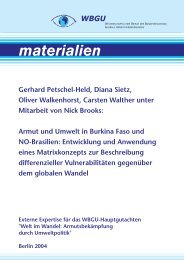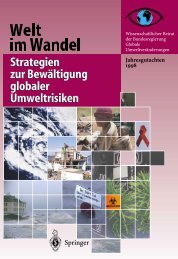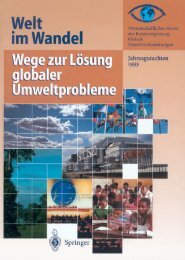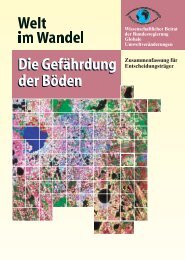World in Transition: Climate Change as a Security Risk - WBGU
World in Transition: Climate Change as a Security Risk - WBGU
World in Transition: Climate Change as a Security Risk - WBGU
Create successful ePaper yourself
Turn your PDF publications into a flip-book with our unique Google optimized e-Paper software.
108<br />
6 Conflict constellations<br />
Dis<strong>as</strong>ter and collapse of state functions<br />
Bad governance and<br />
<strong>in</strong>ternal political<br />
tensions<br />
Social tensions<br />
Wan<strong>in</strong>g<br />
bilateral conflict<br />
Outset situation<br />
Conflicts <strong>in</strong><br />
power vacuums<br />
De-escalation<br />
through relief efforts<br />
dis<strong>as</strong>ters certa<strong>in</strong>ly represent opportunities to overcome<br />
entrenched political-ideological differences. In<br />
the c<strong>as</strong>e of conflicts <strong>in</strong>volv<strong>in</strong>g several parties or an<br />
<strong>in</strong>cre<strong>as</strong><strong>in</strong>g level of tensions, there appears to be relatively<br />
little prospect of de-escalation.<br />
6.4.2.4<br />
The time sequence of dis<strong>as</strong>ter-<strong>in</strong>duced conflict<br />
mechanisms<br />
State functions restored<br />
Conflicts while state<br />
functions are restored<br />
0 approx. 2 days approx. 1 week approx. 2 years<br />
Possible developments<br />
Figure 6.4-2 shows a simplified cl<strong>as</strong>sification of the<br />
mechanisms presented and their progression over<br />
time. The collapse of state functions is both an <strong>in</strong>herent<br />
component of large-scale natural dis<strong>as</strong>ters and a<br />
precondition for the conflict mechanisms described.<br />
The latter are l<strong>in</strong>ked to specific outset situations, but<br />
can also occur <strong>in</strong> comb<strong>in</strong>ed forms <strong>in</strong> certa<strong>in</strong> circumstances.<br />
Where<strong>as</strong> de-escalation may beg<strong>in</strong> from the<br />
first offer of <strong>as</strong>sistance, generally loot<strong>in</strong>g will only<br />
start to happen two days after the dis<strong>as</strong>ter event.<br />
Intra state conflicts will not normally escalate until<br />
after the ma<strong>in</strong> direct consequences of the dis<strong>as</strong>ter<br />
have been responded to.<br />
Overall the preconditions under which conflicts<br />
will be triggered or amplified can be summarized <strong>in</strong><br />
terms of key factors, which are briefly outl<strong>in</strong>ed below.<br />
The typical mechanisms of action are presented schematically<br />
<strong>in</strong> Figure 6.4-3.<br />
The dimension of <strong>in</strong>fluence [1] Physical threat to<br />
a location or a region depends substantially on the<br />
<strong>in</strong>tensity and frequency of extreme events. The level<br />
of threat is not purely a function of <strong>in</strong>dividual factors<br />
like precipitation levels and w<strong>in</strong>d speed, but also<br />
depends on geographical location (e.g. low-ly<strong>in</strong>g co<strong>as</strong>t<br />
or river valley). Other key factors that come <strong>in</strong>to play<br />
are, <strong>in</strong> many c<strong>as</strong>es, partly <strong>in</strong>fluenced by human activities.<br />
Examples are the deforestation of river b<strong>as</strong><strong>in</strong>s,<br />
which <strong>in</strong>cre<strong>as</strong>es peak run-off (the highest water level<br />
Escalation of<br />
<strong>in</strong>tr<strong>as</strong>tate conflicts<br />
Negotiations<br />
Figure 6.4-2<br />
Characteristic time<br />
sequence of dis<strong>as</strong>ter-<strong>in</strong>duced<br />
conflict mechanisms.<br />
Intensity of colour <strong>in</strong>dicates<br />
<strong>in</strong>tensity of conflict.<br />
Source: <strong>WBGU</strong><br />
on a water gauge dur<strong>in</strong>g a flood), and the subsidence<br />
of cities due to <strong>in</strong>cre<strong>as</strong>ed groundwater abstraction.<br />
Influence dimension [2] Vulnerability to extreme<br />
events groups together the key factors which determ<strong>in</strong>e<br />
whether an event will actually unle<strong>as</strong>h cat<strong>as</strong>trophic<br />
effects or whether people and <strong>in</strong>fr<strong>as</strong>tructure<br />
will escape largely unscathed. A significant key factor<br />
here is population density and the concentration<br />
of property and <strong>as</strong>sets <strong>in</strong> are<strong>as</strong> at risk. The flood<strong>in</strong>g<br />
of an un<strong>in</strong>habited river valley is not, <strong>in</strong> itself, a natural<br />
dis<strong>as</strong>ter. The dev<strong>as</strong>tation of critical <strong>in</strong>fr<strong>as</strong>tructure<br />
facilities such <strong>as</strong> hospitals, transport and communication<br />
nodes by extreme events, on the other hand, is<br />
a crucial feature of dis<strong>as</strong>ters. However, vulnerability<br />
is also determ<strong>in</strong>ed by economic, social and organizational<br />
characteristics. Besides the nature and extent<br />
of dis<strong>as</strong>ter preparedness, factors such <strong>as</strong> poverty, economic<br />
structure and educational level are also critical.<br />
P<strong>as</strong>t experience h<strong>as</strong> shown that dis<strong>as</strong>ter exposes poor<br />
population groups to a disproportionately higher risk<br />
than wealthy population groups (UNISDR, 2004).<br />
Whether the temporary breakdown of state order<br />
<strong>in</strong> dis<strong>as</strong>ter situations is abused by non-state actors<br />
for crim<strong>in</strong>al ends depends essentially on dimension<br />
of <strong>in</strong>fluence [3] Social stability. In many societies,<br />
dis<strong>as</strong>ters lead to higher levels of <strong>in</strong>ternal cohesion<br />
and widespread helpfulness (Fuentes, 2003; Auf<br />
der Heide, 2004); <strong>in</strong> different milieus, they lead to the<br />
emergence of crim<strong>in</strong>al gangs and looters. It is <strong>as</strong>sumed<br />
that a raised crime rate is most likely <strong>in</strong> places where<br />
social tensions and crime have been known problems<br />
beforehand. This <strong>as</strong>sumption is supported by observations<br />
<strong>in</strong> the USA (Auf der Heide, 2004). Social tensions<br />
are often the expression of large <strong>in</strong>come disparities,<br />
a high unemployment rate, and social and ethnic<br />
segregation. Social <strong>in</strong>equality is also cited <strong>as</strong> a key<br />
factor with negative repercussions for the stability of<br />
post-dis<strong>as</strong>ter states (Drury and Olson, 1998). The<br />
explanation offered is that <strong>in</strong> societies with severe<br />
social <strong>in</strong>equality, poorer sections of the population
















